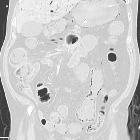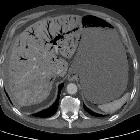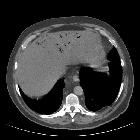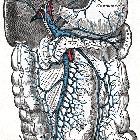portalvenöses Gas































 nicht verwechseln mit: Aerobilie
nicht verwechseln mit: AerobiliePortal venous gas is the accumulation of gas in the portal vein and its branches. It needs to be distinguished from pneumobilia, although this is usually not too problematic when associated findings are taken into account along with the pattern of gas (i.e. peripheral in portal venous gas, central in pneumobilia).
Pathology
Etiology
Although traditionally considered a harbinger of death, portal venous gas is increasingly recognized in a variety of conditions, many of which do not carry as high mortality or morbidity risks.
Causes of portal venous gas are best divided according to the age of the patient:
- child
- umbilical vein catheterization
- necrotizing enterocolitis (NEC)
- neonatal gastroenteritis
- erythroblastosis fetalis
- postoperative finding in corrective bowel surgery
- adult
- alterations of the bowel wall
- ischemic bowel (usually mural gas as well as mesenteric gas: mortality of 75-90%, but gas is not an independent predictor)
- necrotic/ulcerated colorectal carcinoma (CRC)
- inflammatory bowel disease (IBD)
- perforated peptic ulcer
- bowel luminal distention
- iatrogenic gastric and bowel dilatation (e.g. upper and lower endoscopic procedures, enemas)
- paralytic ileus / mechanical bowel obstruction
- acute gastric dilatation
- barotrauma
- intra-abdominal sepsis
- unknown mechanism
- pneumatosis intestinalis
- chronic obstructive pulmonary disease (COPD)
- corticosteroid usage
- diabetes
- diarrhea
- cardiopulmonary resuscitation
- alterations of the bowel wall
Radiographic features
Plain X-ray
Branching lucencies projected in the liver or vessels coursing towards the liver.
Ultrasound
Gas in the portal veins usually manifests as echogenic mobile foci in the lumen of the portal vein. Doppler US will demonstrate sharp spikes on both sides of the basal line on the Doppler spectral display .
CT
Similar to X-ray features, portal venous gas manifests on CT as branching gaseous foci of low density in the liver, portal vein and its tributaries. The vessel-gas interface may cause streak artifact. Typically, the gas in the liver is peripheral which helps differentiate it from more central gas due to pneumobilia).
See also
Siehe auch:
- Aerobilie
- Pneumatosis intestinalis
- Mesenterialinfarkt
- Nekrotisierende Enterokolitis
- Kolorektales Karzinom
- Divertikulitis
- Vena portae
- Chronisch-entzündliche Darmerkrankungen
- Dünndarmischämie
- Chronisch obstruktive Lungenerkrankung
- Appendizitis
- Cholezystitis
- Gas in Pfortader und Mesenterialvenen bei mesenterialem Infarkt
- abnormales Gas im Abdomen
- Cholangitis
- Gas in der Leber
- portal venous gas: benign aetiology
- Gas im Pfortadersystem beim Neugeborenen
- portal venous gas with pyloric stenosis
- Gas im Pfortadersystem bei nekrotisierender Enterokolitis
- erythroblastosis fetalis
und weiter:
- pneumobilia vs portal venous gas (mnemonic)
- Milzabszess
- pathological conditions of hepatic vascularization
- pneumatosis intestinalis and hepatic portal venous gas
- necrotising enterocolitis staging
- mesenteric ischaemia with intestinal necrosis
- gastric ischaemia from over-eating
- saber sign in pneumobilia
- Gas Luft in Echinococcuszyste der Leber

 Assoziationen und Differentialdiagnosen zu portalvenöses Gas:
Assoziationen und Differentialdiagnosen zu portalvenöses Gas:










